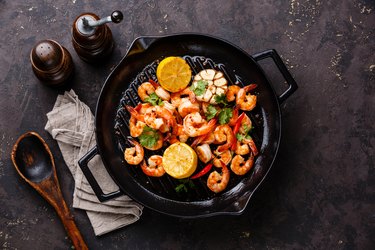
Caloric values for foodstuffs are often given for the raw or uncooked food. Cooking food can significantly alter its nutritional profile and the number of calories present in the same quantity by weight. Compare the calories in cooked vs. raw foods for an accurate picture of your daily consumption.
If you are watching your calories for purposes of weight loss or weight control, it is also important to consider how the method of cooking your food may alter its caloric content.
Video of the Day
Video of the Day
Tip
Cooking food causes a loss of water content, which can change the number of calories by weight. Cooking methods, such as frying, can increase calorie content of food significantly when compared to its raw counterpart.
Calories: Cooked Versus Raw
To use the example of chicken — breast meat only, no skin — you can see the difference in caloric and nutritional values with different modes of cooking. According to the USDA, 4 ounces of raw chicken contains 136 calories.
When the same piece of chicken is fried, its caloric value increases to 312 calories in a 4 ounce serving. If roasted, this serving of chicken has 220 calories.
Consider Cooking Methods
Cooking a food in oil, butter or another fat will add to the foods caloric content. This happens because you are adding calories to the food through the addition of fats, batter or breading.
The concentration of calories in fats and oils is very high, so even a small weight amount of oil or fat used in cooking can have a significant impact on the caloric value of your food. Using the example of the chicken breast, frying the raw breast adds 84 calories — a 62 percent increase.
When food is grilled or broiled, fat and water from the food typically drip and drain away from the food so that they are not consumed in the cooked foodstuff. Mayo Clinic recommends baking, braising, grilling, broiling, poaching, roasting and steaming as healthy cooking methods which do not add calories through cooking fat.
Read more: How to Cook Healthy Meals Without a Recipe
Loss of Water Weight
You might wonder why, even when foods are cooked without additional fat, their caloric values per 4 ounces nevertheless increase slightly. One answer to this question is that water present in the raw food is often lost during cooking, and this increases the density and therefore the caloric value of the cooked food.
For example, 4 ounces of raw chicken contains 98.5 grams of water, according to the USDA. When this chicken meat is cooked through roasting, water is lost so that there is 83.5 grams of water present in every 4 ounces of roasted meat.
Calories in Cooked Vegetables
Although cooking vegetables in water doesn't alter it's calorie content significantly, it does affect its nutrients, according to University of California, Davis. Nutrient content is also affected by the amount of time that passes between harvested the food and consumption.
Some produce spends several weeks in transit between the place where it was grown to the consumer's table. Plant metabolism increases after it's harvested, which causes water loss and breakdown in nutrient content.
Cooking also affects nutrient content of vegetables, and can affect calorie content as well. Water-soluble nutrients such as B and C vitamins leached into water when they are cooked. Sauteing veggies in oil or topping them with butter increases fat content and calories in cooked vegetables.
- Mayo Clinic: "Healthy Cooking Techniques"
- USDA FoodData Central: "Chicken, Broiler or Fryers, Breast, Skinless, Boneless, Meat only, Raw"
- USDA FoodData Central: "Chicken, Breast, Roasted, Broiled, or Baked, Skin Not Eaten"
- USDA FoodData Central: "Chicken, Breast, Coated, Baked or Fried, Prepared Skinless, Coating Eater, Made with Butter"
- University of California, Davis: "Maximizing the Nutritional Value of Fruits & Vegetables"